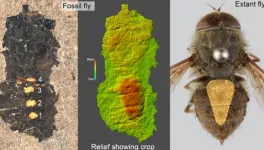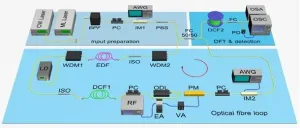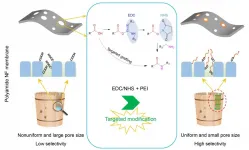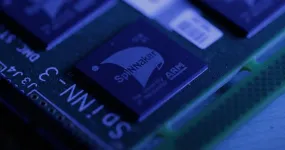Seeing both sides of light collection
2021-03-11
(Press-News.org) Two types of materials are better than one when it comes to solar cells, as revealed by an international team that has tested a new combination of materials and architecture to improve solar-cell efficiency.
Silicon has long dominated as the premier material for solar cells, helped by its abundance as a raw material. However, perovskites, a class of hybrid organic-inorganic material, are a viable alternative due to their low-cost and large-scale manufacture and potentially higher performance. While still too unstable for full commercialization, they might become available to the market by 2022.
KAUST's Michele De Bastiani and Stefaan De Wolf, working with colleagues in Canada, Germany and Italy, now show that a combination of the two is the best approach. By optimizing the material composition and the architecture of a "tandem" device, the team has achieved efficiencies beyond commercial silicon solar panels.
Sunlight, of course, comes directly from the sun, but illumination also comes from light reflecting off other surfaces, known as albedo. A device architecture that collects light from the back as well as from the front can utilize this source. "Our bifacial tandems exploit both direct sunlight and the albedo to generate electricity in a more efficient way than their conventional counterparts," explains De Bastiani.
He and the team started with a simple silicon device structure that was textured top and bottom to enhance light collection. They then used a solution-processing method to deposit a thin perovskite layer on top. A transparent back electrode allowed light in while also allowing a current to flow out. The researchers tested five perovskite materials, each with a different chemical composition, to increase the absorption of incoming light. In this way, they were able to identify the perovskite that best matched the electronic properties of the silicon.
"A restriction of the tandem configuration is the limited current through the lower of the two subcells," says De Bastiani. "We designed our tandem with a unique feature: the perovskite subcell generates more current than the silicon counterpart by stealing light that would be otherwise absorbed by the bottom subcell."
The team tested their bifacial devices and compared the performance to similar monofacial devices in various outdoor settings with a range of albedos, such as, for example, bright sandstone or concrete. They found that, in all conditions, the bifacial configuration outperformed the monofacial one.
"We are now investigating the stability of the perovskite while also scaling up the technology to the module level," says De Bastiani. "For this, we are looking for industrial partners and sponsors."
INFORMATION:
[Attachments] See images for this press release:
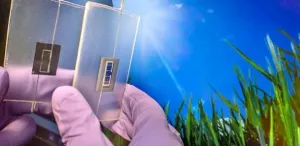
ELSE PRESS RELEASES FROM THIS DATE:
2021-03-11
It was not the fly itself that caught the scientists' attention, but its bulging abdomen suggesting it was still full with the fly's last food intake. Surprisingly, analysis of the stomach content revealed it was full with pollen from different plants. The fossil pollen from the fly's stomach was used to reconstruct the ancient environment inhabited by the fly, the biotic interactions between plant and fly, and the fly's behaviour during feeding.
Flies as pollinators
Today, bees, butterflies and bumblebees are the typical pollinators, which are also known to feed on pollen. That flies also play an important role in pollination ...
2021-03-11
BOs describe the periodic movement of electrons in solids to which an external static electric field is applied. However, it is challenging to measure the BOs directly in natural solids since the relaxation time of electrons is usually much shorter than the oscillation period. To date, analogies of electron BOs have been extended to the synthetic dimensions of time, frequency and angular momenta. In previous studies, the frequency BOs have been experimentally demonstrated in a nonlinear fibre with cross-phase modulation. However, the frequency spectrum has ...
2021-03-11
An innovative analysis of two-dimensional (2D) materials from engineers at the University of Surrey could boost the development of next-generation solar cells and LEDs.
Three-dimensional perovskites have proved themselves remarkably successful materials for LED devices and solar panels in the past decade. One key issue with these materials, however, is their stability, with device performance decreasing quicker than other state-of-the-art materials. The engineering community believes the 2D variant of perovskites could provide answers to these performance issues.
In a study published in The Journal of Physical Chemistry Letters, researchers from Surrey's Advanced Technology Institute (ATI) detail how to improve the physical properties of 2D perovskite called Ruddlesden-Popper.
The study ...
2021-03-11
Recently, a research group led by Prof. WAN Yinhua from the Institute of Process Engineering (IPE) of the Chinese Academy of Sciences developed a novel targeted modification strategy to improve the separation selectivity of polyamide NF membranes.
The study was published in Journal of Membrane Science on March 10.
The low selectivity of commercial nanofiltration (NF) membranes to monosaccharides and monovalent salts is mainly due to the nonuniform pore size distribution and strong electronegativity.
Targeted modification can regulate the pore size distribution and electronegativity of polyamide NF membranes, and thus improve the separation selectivity.
In the strategy, carboxyl groups (-COOH) on the surface are activated by N-(3-Dimethylaminopropyl)-N'-ethyl ...
2021-03-11
An international collaboration headed by researchers from iPSYCH has found genetic variants that increase the risk of aggression in children with ADHD. In the same study, the researchers also discovered that the genetics which increase aggression in some children with ADHD, are the same genetics that affect aggression in children without a diagnosis.
For the first time, researchers have found positions in the genome that increase the risk of getting ADHD with disruptive behaviour disorders (DBDs). DBDs are child psychiatric disorders characterised by antisocial and ...
2021-03-11
Most new achievements in artificial intelligence (AI) require very large neural networks. They consist of hundreds of millions of neurons arranged in several hundred layers, i.e. they have very "deep" network structures. These large, deep neural networks consume a lot of energy in the computer. Those neural networks that are used in image classification (e.g. face and object recognition) are particularly energy-intensive, since they have to send very many numerical values from one neuron layer to the next with great accuracy in each time cycle.
Computer scientist Wolfgang Maass, together with his PhD student Christoph Stöckl, has ...
2021-03-11
The genetics of human eye colour is much more complex than previously thought, according to a new study published today.
An international team of researchers led by King's College London and Erasmus University Medical Center Rotterdam have identified 50 new genes for eye colour in the largest genetic study of its kind to date. The study, published today in Science Advances, involved the genetic analysis of almost 195,000 people across Europe and Asia.
These findings will help to improve the understanding of eye diseases such as pigmentary glaucoma and ocular albinism, where eye pigment levels play a role.
In addition, the team found ...
2021-03-11
Extremely preterm infants can suffer from a life-threatening inflammation of the gut. A new clinical study has shown that supplements of a lactic acid bacterium may have positive effects by increasing the diversity of intestinal bacteria in these infants. The study has been led by researchers at Linköping University, Sweden, and published in the scientific journal Cell Reports Medicine.
A litre of milk weighs a kilogram. Most infants who are born extremely prematurely weigh less than that. An infant who should have developed and grown for three more months in the protective environment of the mother's womb is, of course, extremely vulnerable. As a consequence of advances in neonatal care, many premature infants survive, although one out of four of the extremely ...
2021-03-11
Robots solving computer games, recognizing human voices, or helping in finding optimal medical treatments: those are only a few astonishing examples of what the field of artificial intelligence has produced in the past years. The ongoing race for better machines has led to the question of how and with what means improvements can be achieved. In parallel, huge recent progress in quantum technologies have confirmed the power of quantum physics, not only for its often peculiar and puzzling theories, but also for real-life applications. Hence, the idea of merging the two fields: on one hand, artificial intelligence ...
2021-03-11
Scientists have discovered a route of introduction for High Pathogenicity Avian Influenza Virus (HPAIV) H5N8 into Japan and, in parallel, have investigated the potential of two human anti-influenza drugs for the control of HPAI in birds.
Since October 30, 2020, there have been over 30 recorded outbreaks of High Pathogenicity Avian Influenza (HPAI) in domestic poultry and wild fowl in Japan. This outbreak was caused by the influenza A virus H5N8, a known High Pathogenicity Avian Influenza Virus (HPAIV). In such a scenario, identification of the source of the virus and its transmission route is important to control its spread.
A team of scientists led by Professor Yoshihiro Sakoda of Hokkaido University have recently found the probable route of introduction of ...
LAST 30 PRESS RELEASES:
[Press-News.org] Seeing both sides of light collection

